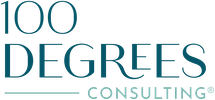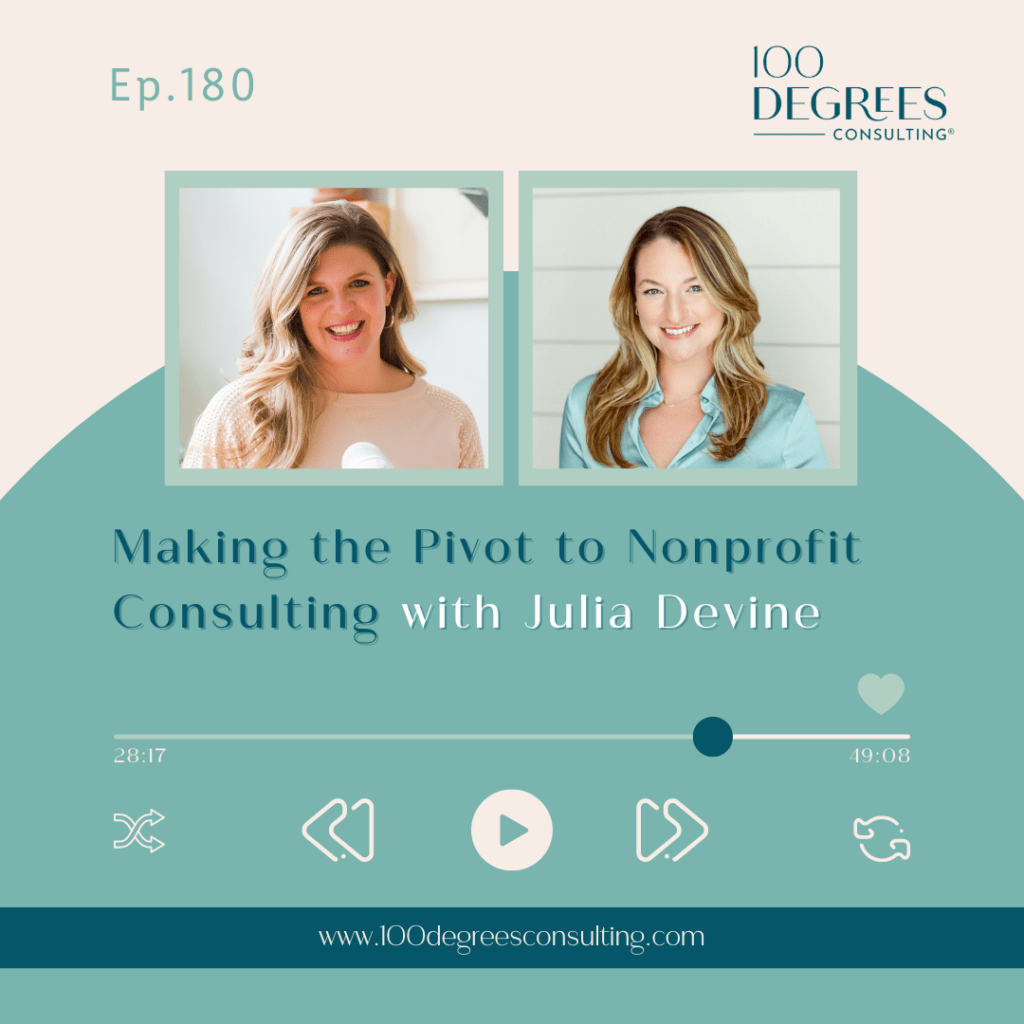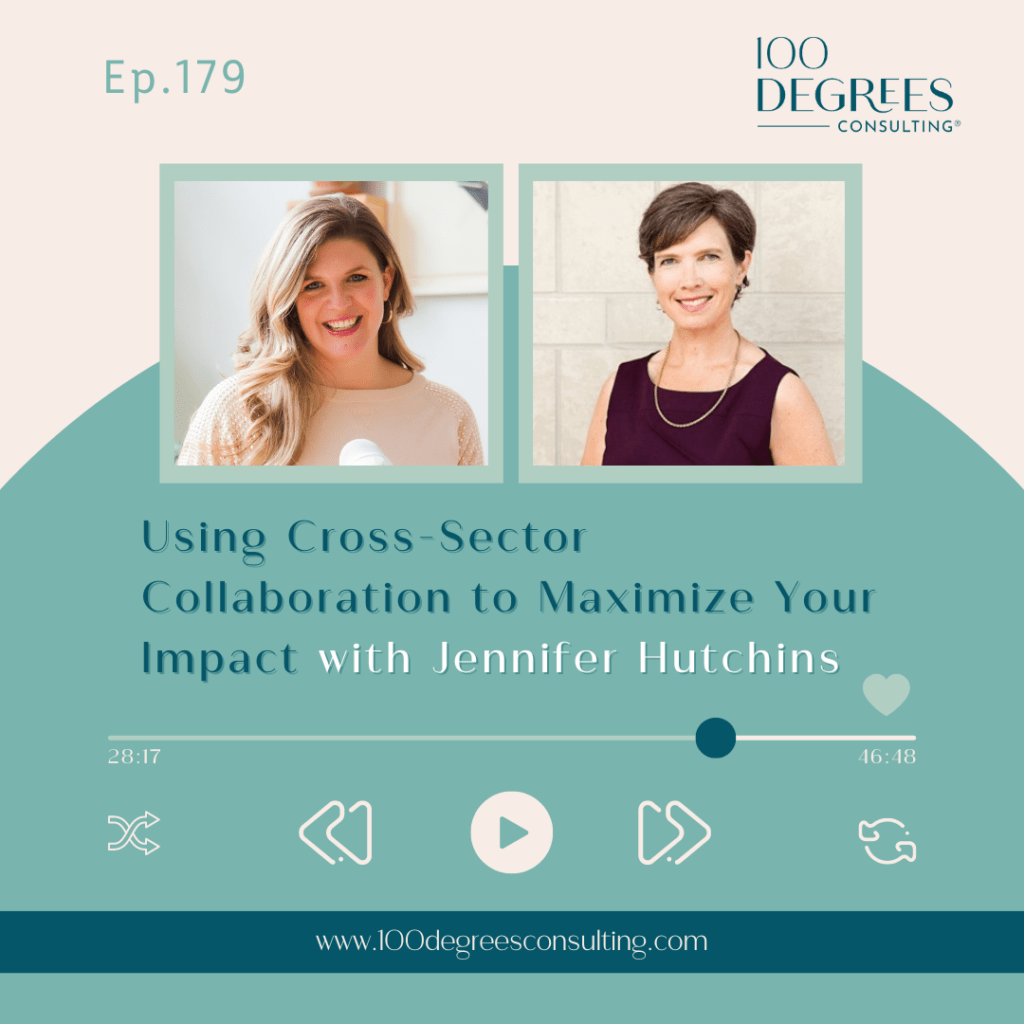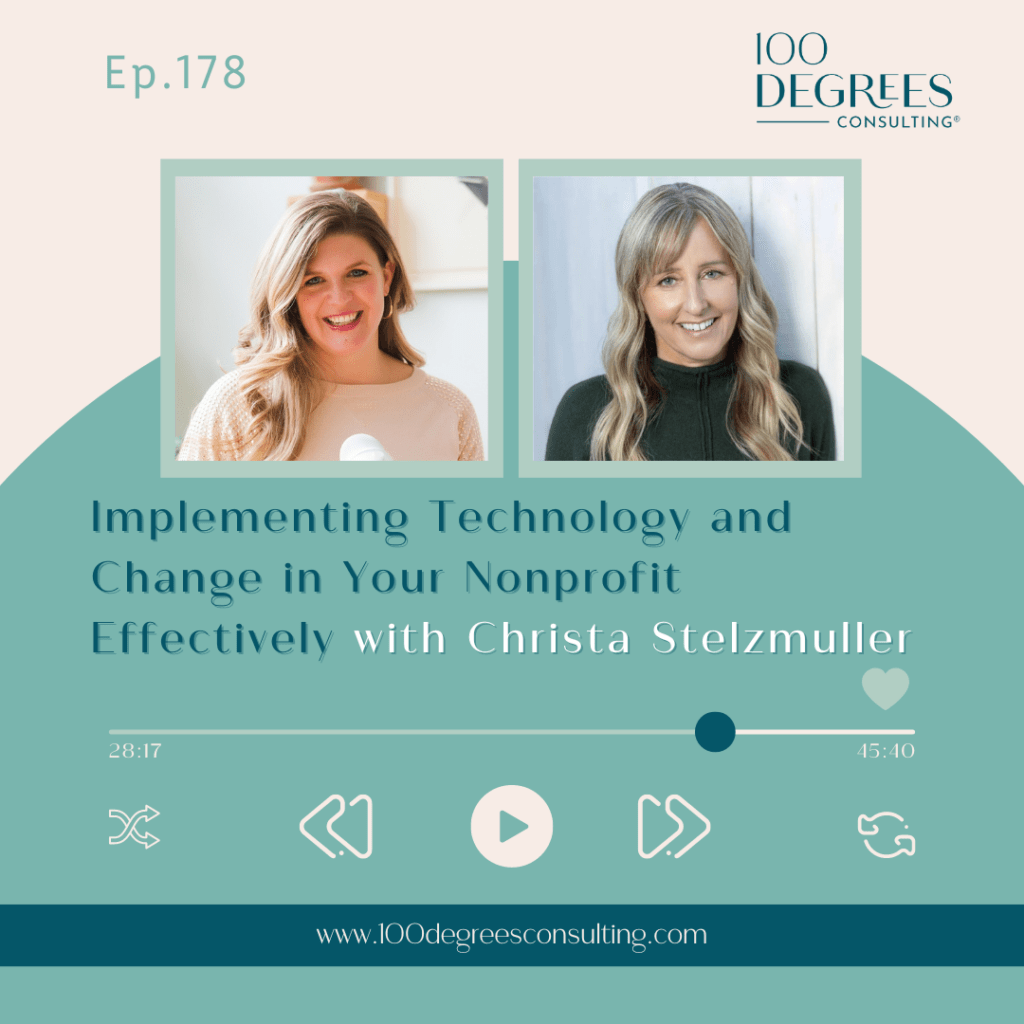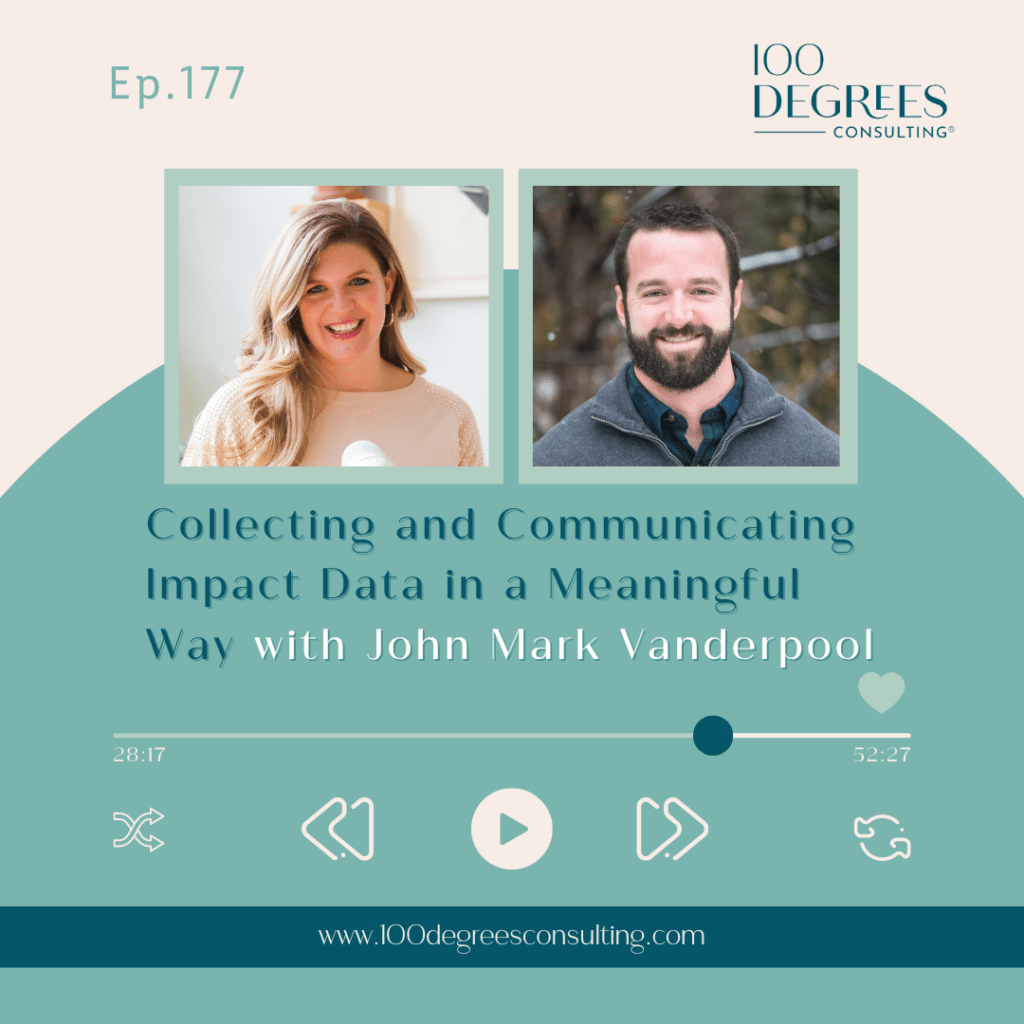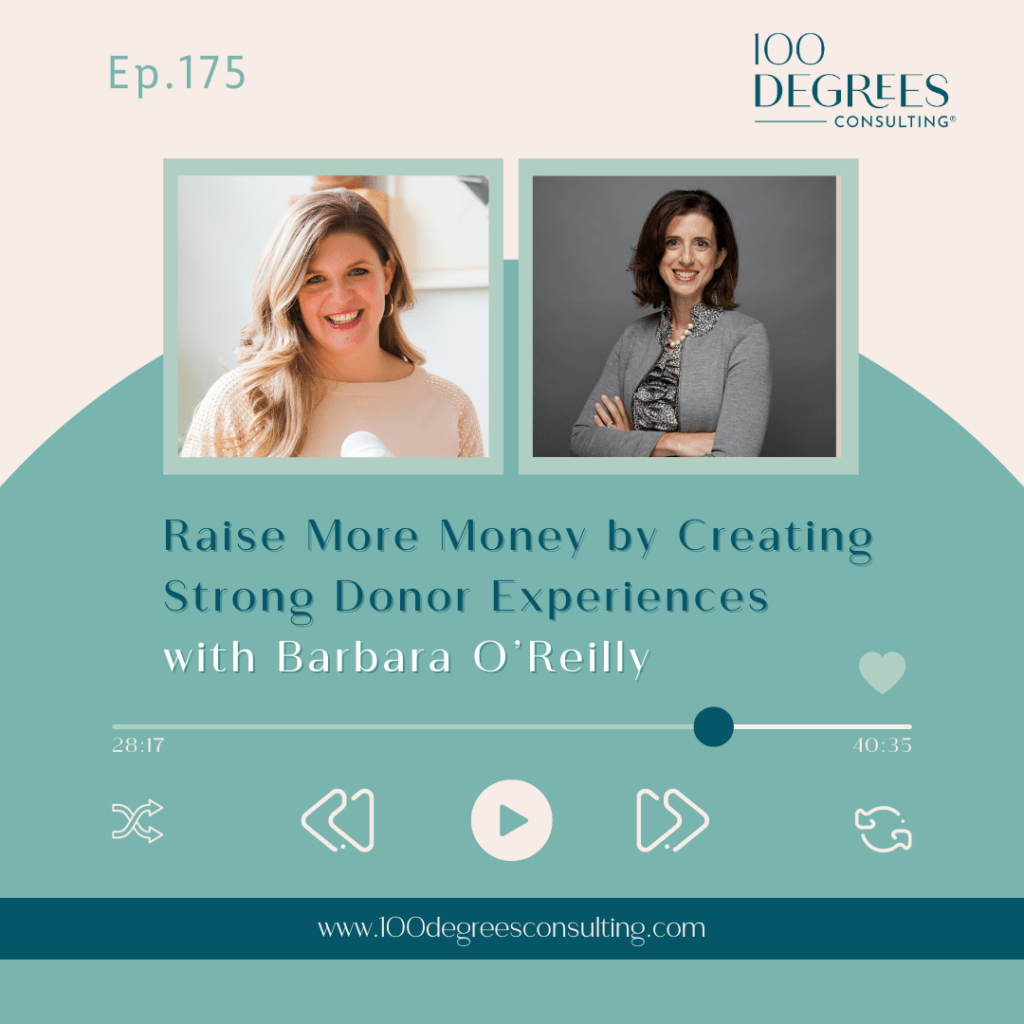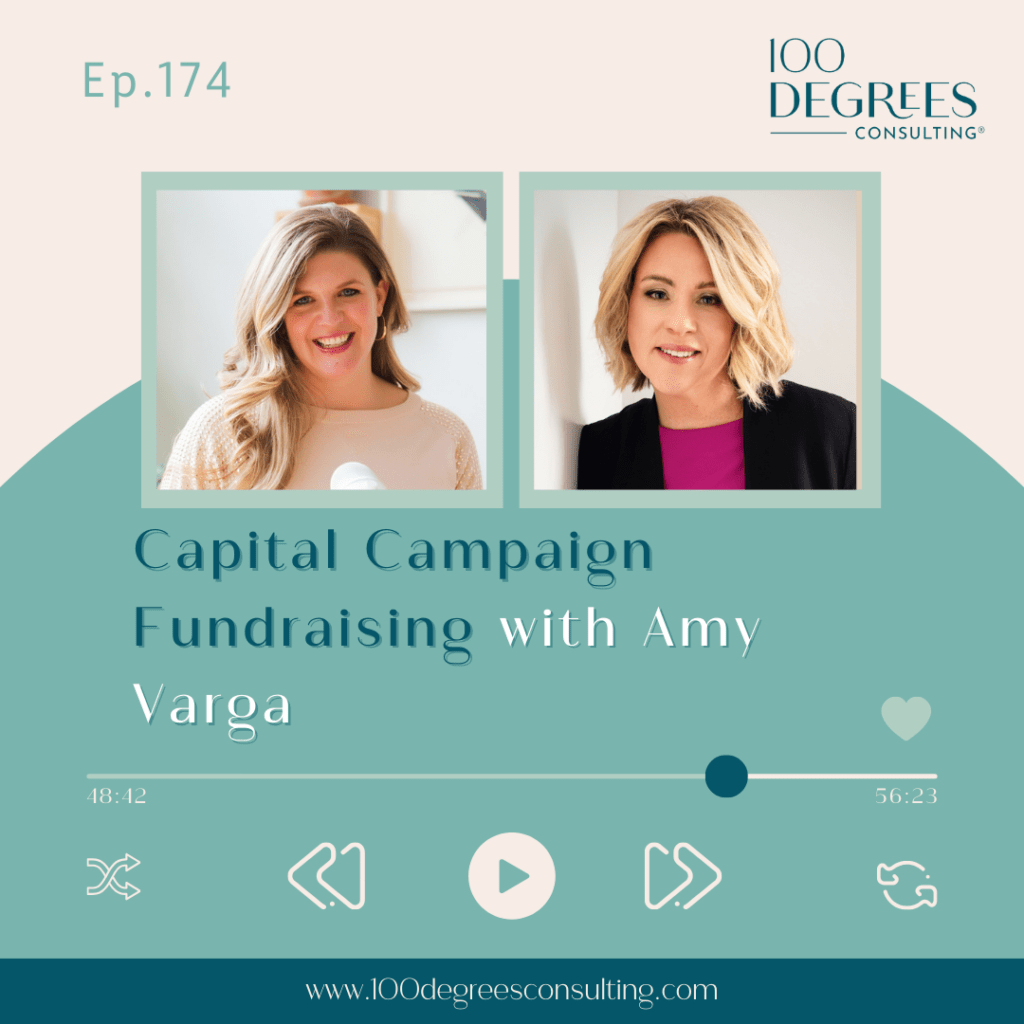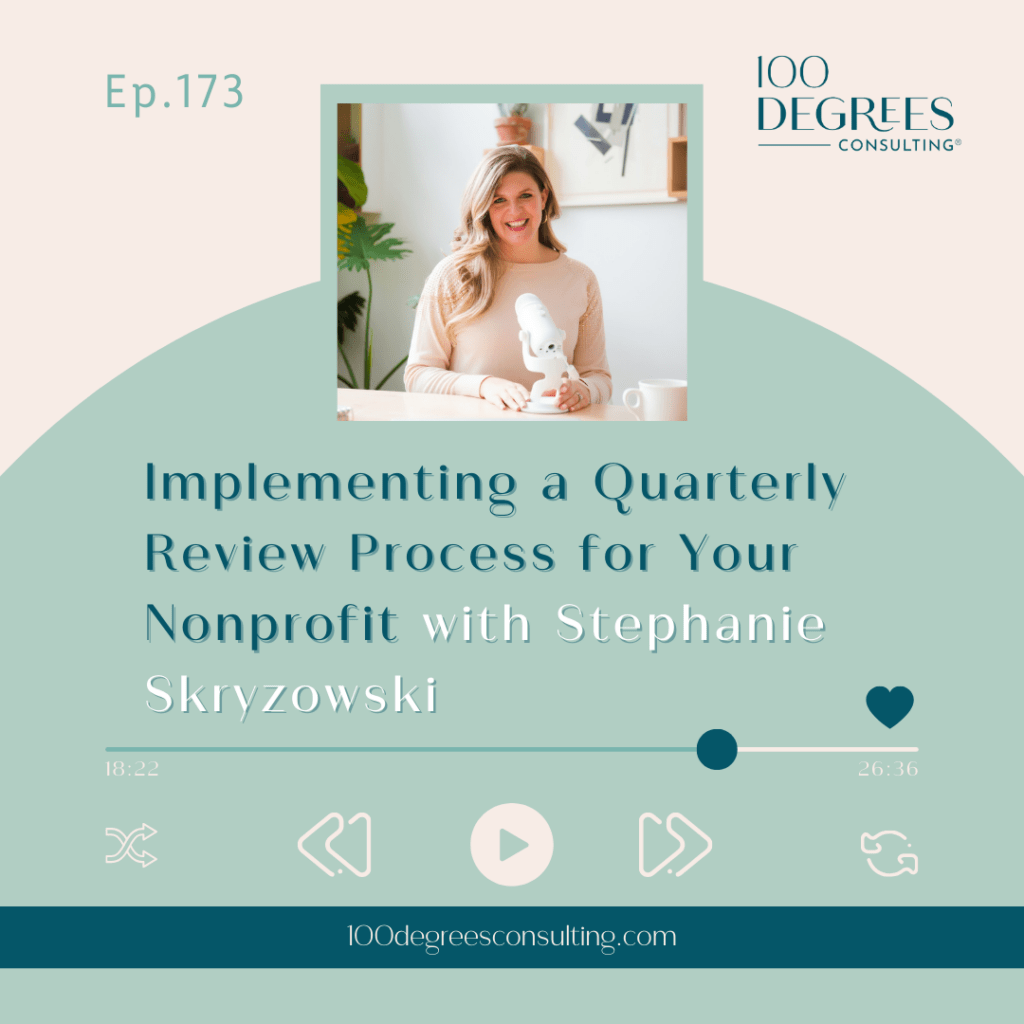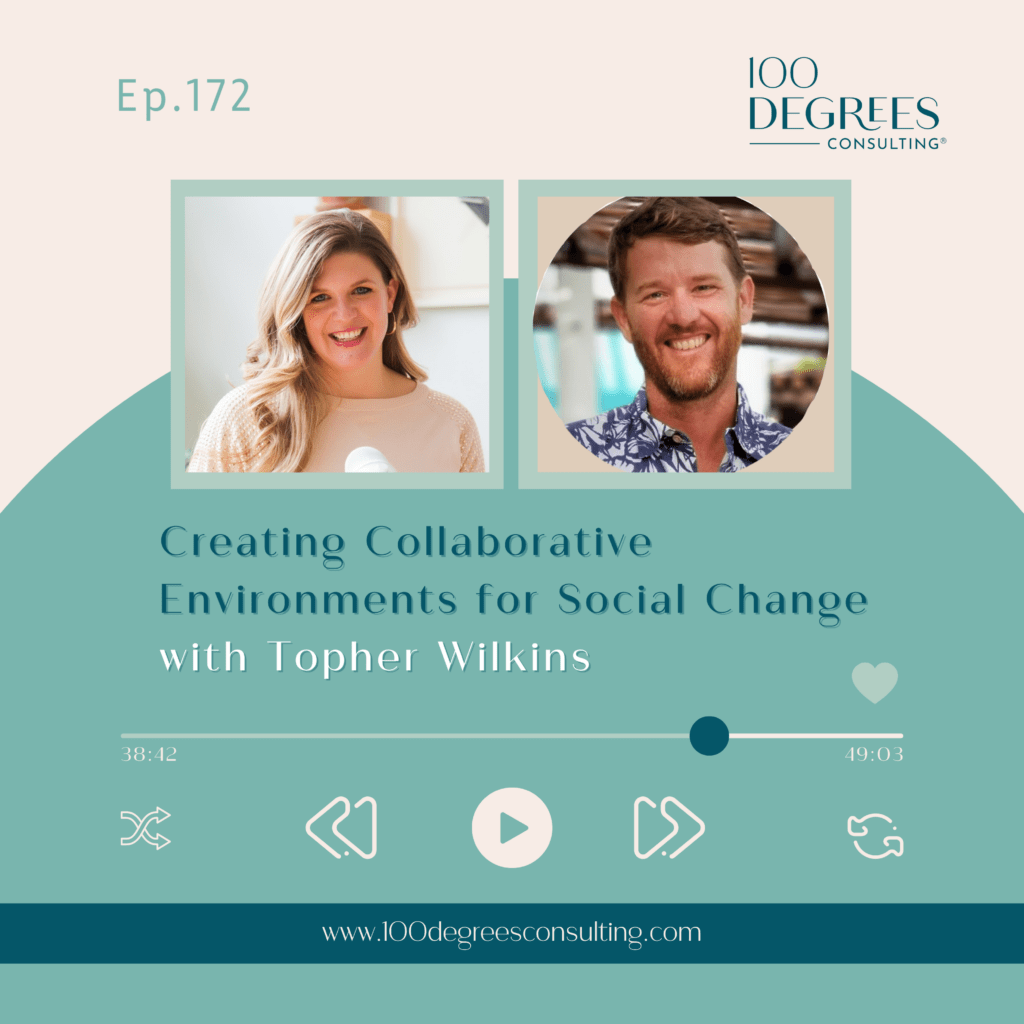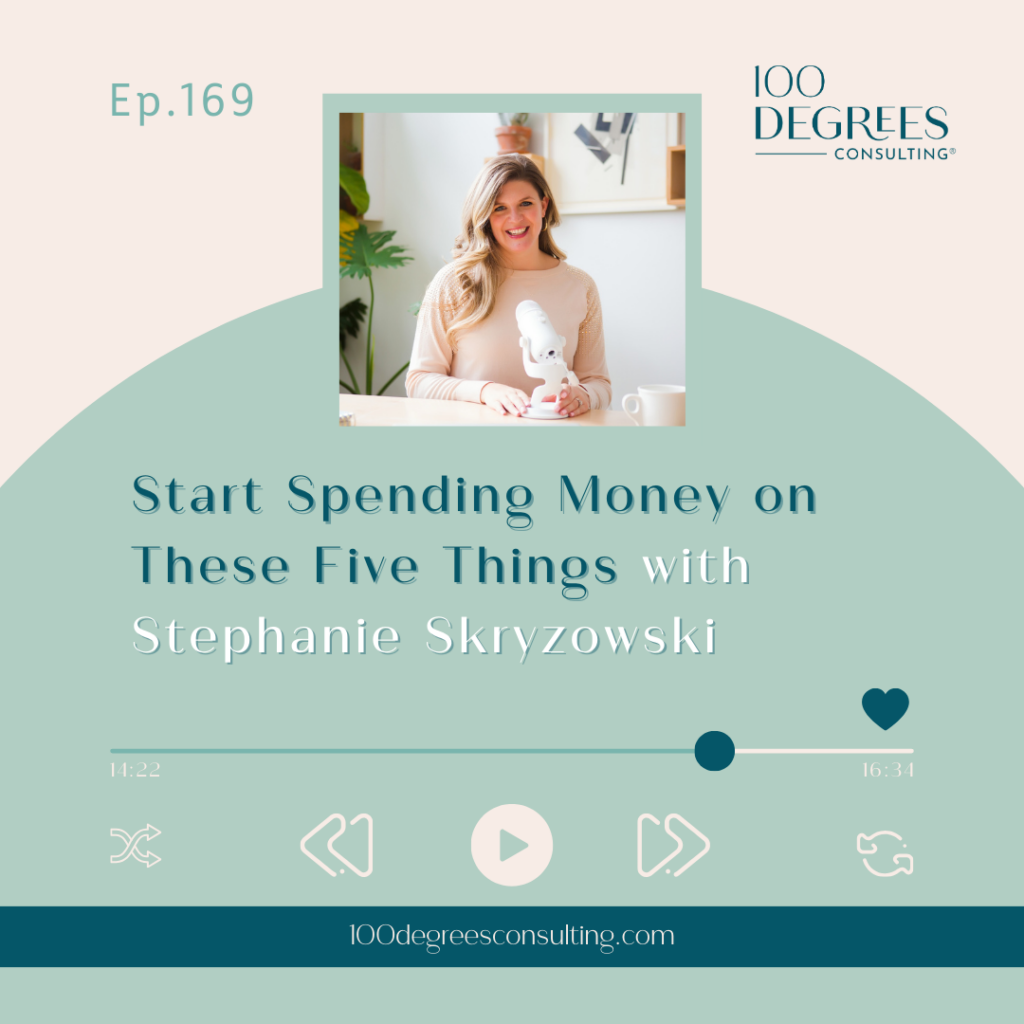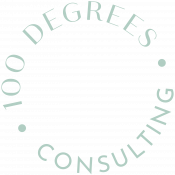Transcript Episode 175 – Raise More Money by Creating Strong Donor Experiences with Barbara O’Reilly on The Prosperous Nonprofit
[00:00:00] Stephanie Skryzowski: Welcome to the Prosperous Nonprofit, the podcast for leaders who are building financially sustainable and impactful nonprofits and changing the world. I’m Stephanie Skrzewski, a chief financial officer and founder and CEO of 100 Degrees Consulting. My personal mission is to empower leaders to better understand their numbers, to grow their impact and their income.On this show, we talk to people who are leading the nonprofit sector in new, Innovative, disruptive, and entrepreneurial ways, creating organizations that fuel their lives, their hearts, and their communities. Let’s dive in.
Hey everyone. Welcome back to the Prosperous Nonprofit. This is Stephanie Skarzelski, your host. And today I have on the show with me, Barbara O’Reilly. Welcome. Barbara is a seasoned fundraising consultant on a mission to help more nonprofits raise more money by [00:01:00] creating strong donor experiences. Whether it was leading record setting reunion classes, securing tens of millions of dollars from global corporations, following some of the most devastating natural disasters around the world, or, Overseeing a team that grew donor engagement of major individual donors, Barbara knows that fundraising is much more than just asking for money.
Her firm, Windmill Hill Consulting, and yes, I asked her what the history is behind Windmill Hill Consulting, and she tells us a wonderful story. She works with organizations, giving them the resources, skills, and mindset they need to build stronger donor relationships and catapult their revenue. She serves as the past president of the Association of Fundraising Professionals, Washington DC Metro Chapter.
She sits on the board of the BBB Wise Giving Alliance, that’s Better Business Bureau, and AFP Foundation and chairs the research committee for the Giving USA Foundation. In 2020, she joined the faculty at the University of Maryland’s Do Good Institute, teaching nonprofit fundraising. So not only is she an [00:02:00] experienced fundraiser, she is also a really, really instrumental in the fundraising community at large.
So we have a lot of wisdom on this call today. And so we started by really talking a lot about largely what’s holding non profits back and how they can really. Really grow to be organizations that are financially strong. And if you’re a small organization, how do you get there? So we talked a lot about building relationships and consistency and the importance of that.
And this is just a fantastic conversation. I think Barbara really brings a lot of wisdom. I loved our conversation around. Specifically, I’ve seen nonprofit organizations hire a fundraiser. And then when that fundraiser has not brought in, you know, a lot of money in the first six months, fire them because expectations were not aligned.
And so Barbara talks about the real deal, what it really looks like to help a fundraiser be [00:03:00] successful at a nonprofit organization. So this episode is full of good ones. However, let me tell you that my internet and then internet and my entire neighborhood decided to quit. What we. We were just wrapping up.
So I didn’t get to ask Barbara my favorite question, which you all know, what does a prosperous nonprofit look like to you? So I’m super bummed about that. That’s why we do not have that question on here. Um, but I’m going to tell you right now in advance where to find out more about Barbara. So again, her name is Barbara O’Reilly and she owns Windmill Hill Consulting and their website is whillconsulting.
com. So that would be a great place to go to, to check out the work that she’s doing. And then you can find her on LinkedIn as Barbara O’Reilly, of course. And so we’ll put all the links for Barbara in the show notes. So you have all of that, um, but this was a fantastic episode, just again, chock full of fundraising wisdom from a veteran in the industry.
So without further ado, let’s go talk to Barbara.[00:04:00]
Hi everyone. Welcome back to the Prosperous Nonprofit. I’m thrilled to be here with you today with Barbara O’Reilly. Barbara, welcome. Oh, thanks Stephanie. Glad to be here. I am super excited to chat all things fundraising with you today. As I know you have a ton of experience. You are a seasoned fundraising consultant and I want to hear all the things, but first I would love for you to tell us a little bit about what you do now.
We’re going to get into the journey of how you made it to what you’re doing now, but tell us a little bit about the work that you do now.
[00:04:36] Barbara OReilly: Yeah, thank you. Um, so I have the great honor to be a fundraising consultant with my own practice, Windmill Hill Consulting. I became a consultant about 15 years ago and launched Windmill Hill officially about 10 years ago.And we work with clients, with nonprofits across all, just about all verticals within the sector. And we help them really uncover [00:05:00] The pain points, the true pain points, because often what they say are the pain points are not the pain points for what’s holding them back in their fundraising. So we really help them uncover where are the areas that they need to really double down on, what are the things that they need to avoid.
And what’s the right roadmap for them to build a path for growing and sustaining their fundraising results. And that’s across development strategy as a whole. It’s across campaign planning and strategy and coaching and training of boards and executive leaders.
[00:05:33] Stephanie Skryzowski: Amazing. And is there any particular sector of fundraising that you specialize in or that you work the most in?Are you working in individual donations or institutional funders or just sort of big picture fundraising strategy?
[00:05:48] Barbara OReilly: We work with all kinds of organizations across most of the verticals. So, um, with the exception of a couple, but we bring our collective experiences [00:06:00] in individual major gifts, in corporate fundraising.In campaigns in just overall, uh, you know, annual giving strategy and leadership. Uh, those are certainly the things that I had, uh, in my portfolio when I was in house in organizations. So I’ve brought that to Windmill Hill. And then the team around me also has experience in a lot of different areas, foundations and annual giving.
Major gifts and campaigns. So we collectively can bring all of that together to our clients. And then we partner with others who are specialists in prospect research or donor communications or digital fundraising so that that really we can offer our clients kind of the most comprehensive set of services and support that they need.
[00:06:45] Stephanie Skryzowski: I love that. That’s so good because it is more than just one sort of vertical in terms of raising money. And we talk a lot. I want, you know, I talk a lot about having a diversity of revenue streams. And so I love that you’re able to come into an organization and, and help [00:07:00] with multiple different things.So I have a question for you. And I get this question a lot about my company, 100 Degrees Consulting, Windmill Hill Consulting. Where does that name come from?
[00:07:10] Barbara OReilly: Yeah. So. I started being a consultant about 15 years ago. Then about five years in, I realized that I, I needed to have something more of a brand around me, uh, because I, I wasn’t entirely sure what I wanted in terms of my consulting practice or what that looked like, what the evolution of the business that was not, I hadn’t fully formed that.But when I, Decided that I needed to have a brand for the company. I didn’t want it to be my name because I did want it to be something that had my values and my kind of spirit, but not tied to only to me. And so I thought about the career that I had in house. I got my fundraising career start in at Harvard right out of college and took a job as a staff assistant and As I kind of moved [00:08:00] up in my career, both at Harvard, um, here in D.
C., at a couple of different organizations, and then over in England, I realized that sort of the root of my career and my fundraising success was all started from when I was at Harvard. Uh, I did a little bit of research and this is, you’ll see kind of the nerd in me, but I did a little research and found that John Harvard, when he emigrated from England, had settled in a place just near Cambridge in, uh, Charlestown, I think.
It was called Windmill Hill, and I thought, you know what, that’s perfect because everything that I’ve learned and I kind of attribute to how I am as a fundraiser, both in house and now as a consultant, all stems from those really early days, those formative years as a baby fundraiser, uh, and so I thought Windmill Hill Consulting was sort of that right nod to my start, uh, and where that trajectory took me over these years.
[00:08:52] Stephanie Skryzowski: Oh my gosh. I love that so much. I love a good origin story when it comes to what people name their [00:09:00] businesses. And I agree. Like when I started my business, I didn’t want it to be my name because of the personal brand piece and wanting to grow bigger. And also my last name is incredibly hard to. Spell and pronounce, and I didn’t just want to be like SS consulting.Cause then it sounds like the, you know, the SS minnow or something. So, um, so I had to come up with a creative name as well, but, oh, I love that story. That’s so good. I feel like there’s probably some parallel to a windmill and. The wind and momentum and growth or something. I feel like there’s something there, too You could probably make up
[00:09:37] Barbara OReilly: my daughter Actually, she always jokes and she says uh windmill hill consulting Let us be the wind in your sales or something like your fundraising So she’s so you’re right like she’s picked up on the momentum of the windmill itself And so yeah, and we and we actually in our branding Language, we do talk about sort of the windmill kind of assessing dreaming planning and doing kind of those four You prongs [00:10:00] of how we do our work really, which then kind of underscores the visual of a windmill. [00:10:06] Stephanie Skryzowski: Oh, I love it. That’s so good. I love the tie in. You know, I need to think about that for my brand. Everybody asks what 100 degrees it means and is, and I tell the story and I’m like, Oh, we need to pull that in. Um, so I was in Senegal and I was working for a nonprofit organization and I, um, was laying on the floor where I was sleeping and I had this mosquito net over me and it was midnight.And it was literally a hundred degrees with no air conditioning. I was just super uncomfortable, like kind of miserable, honestly. And I was like, why am I here? Why, why am I even doing this? Like, why am I not home in the air conditioning? Like with my family this summer. And the next day we went to go visit the site, um, where this nonprofit was working and building a school.
And there’s a big celebration with all of the children that would be attending this brand new school came out and I’m like, this is why I’m here. Like this, this is the impact. And so. It was sort of this [00:11:00] nod to like, yeah, it can be really uncomfortable to do this hard work, this amazing work, but it’s so worth it.
Um, and it’s, you know, we really need to just get out of our comfort zone because the impact lies on the other side of that. And so that’s where that came from. It’s, you know, it’s love it. Yeah. Um, but what I haven’t done is integrate that 100 degrees into like our framework. And I love that. So noted. So good.
Awesome. Okay. Well, I want to definitely tap into your fundraising expertise while, while you’re here. And one thing that you talk about is that fundraising is more than just asking for money. And I feel like I saw some like hot take post on LinkedIn recently where I don’t know, people are kind of hating on fundraisers.
And I’m not sure why and I probably should not have even brought this up unless I had more context. But anyway, fundraising is about more than just asking for money. There’s so much more to your work and I would love to hear your take on [00:12:00] that. Tell us more about that.
[00:12:02] Barbara OReilly: Yeah. I mean, if I think back to my in house days before I became a frontline fundraiser, supporting frontline fundraisers.And then when I, when I became a frontline fundraiser. the majority of my work and the work that we were doing was about building relationships. So the asks were, um, part of the conversation, but when they were mistimed, when they were too early, they weren’t successful. And so the real transformational gifts came from just time spent getting to know who the donor was, or whether it was an individual or an institution, and then figuring out what makes sense aligned with their interests, their priorities.
And so, you know, we, and we’ve got a lot of research now, uh, both from fundraising trends and, uh, analyses and also from what we hear from donors. Um, you know, we’ve got the [00:13:00] good fortune to have a lot of donor perspectives that are in surveys and research that comes through in research. Um, that we certainly never had this when I was starting out 30 years ago.
So we know that the real magic happens with, uh, conversations and with really understanding who those donors are, what drives them. But the challenge is, and I’ve seen this also, the challenge is that that takes time. And non profits, most of them do not have the luxury of time. So, You know, spending 12 months to 18 months building a relationship with a donor that they’re going to ask for a large gift feels like it’s a wish list.
It’s kind of like we don’t have that 12 to 18 months. We need the money now. And so there’s always this tension with organizations of all sizes, but you know, to be honest, the larger ones have the budgets and have the financial resources to be able to weather. a longer period of time for those fluctuations and solicitations.
But it is always that, that [00:14:00] tension of how do we do this in a way that is mindful of the many hats that many fundraisers are wearing. All the, you know, multitude of demands on their time and the need to balance the donor’s interests and the donor’s timelines with the organization’s timelines. And this is not just true for major gifts fundraising or large gift fundraising.
It’s very true for annual giving. So, If you send out only solicitations over a period of time. You’re not going to raise more money because people are still wondering, did you get my get my last gift? What’d you do with my last gift? Why do you need more money? Tell me how my gift, my additional gift is going to make a difference.
And so that it has to be very carefully timed and structured as well in terms of those, that cycle of asking, thanking, reporting back. Asking, thanking, reporting back in a way that connects and keeps the conversation going at scale so that donors really, when they’re ready to make those gifts, annual gifts or [00:15:00] other, then they got the information that they need to make an informed decision.
And I do see the backlash against fundraising. I do see the backlash against, um, the relationship. building piece of it. But the reality is that, um, think about our experiences in the for profit side and the retail side and the personalization, the, the recommendations that we get from any company, right?
Any store that we, or any streaming service that we subscribe to, that they learn about us, they’re, they want to get to know us, they might make recommendations, they are, you know, reminding us, Oh, hey, you left something in the cart. I mean, those, they don’t quite translate into the nonprofit side, but the fact that they’re paying attention to us and they’re keeping us connected on a regular basis are the principles that really still translate on the nonprofit side on building those relationships with donors.
So if organizations and especially leaders who put [00:16:00] Sometimes unreasonable pressure on their staff to raise money in a lot of different reasons for time or in goals, um, that are not direct grounded in reality, if the leaders themselves can’t understand the full, all the things that go into fundraising success, then they’re going to get left behind and they’re going to get left behind by.
Fundraisers, donors, organizations who are getting it right, who are building those relationships over time.
[00:16:26] Stephanie Skryzowski: Mm hmm. Oh my gosh. I’ve got like three questions. I need to write them down [00:16:29] Barbara OReilly: before [00:16:30] Stephanie Skryzowski: I forget. That was a really long answer, I realized. No, it’s so good. Okay. I guess the quick question. I have seen nonprofit organizations hire a fundraiser.And think that it is their, their ticket, um, their ticket to a whole big pile of money. And when that big pile of money does not appear in the bank account in like four months, they’re like, well, this fundraiser is a failure and they let them go. Or they’re just [00:17:00] kind of like on the naughty list for another six months.
And then they let them go. It seems to be that there’s a certain amount of runway that needs to be kind of like common knowledge. When we hire a fundraiser, it’s going to take them X amount of time to get up to speed and to start to your point, building those relationships. What have you seen or what should be the expectation that nonprofits have when they’re bringing on a new.
You know, whether it’s a fundraiser in house, a W 2 employee, or a fundraising consultant, what is the runway that we need to have and the realistic expectations that we need to have? So,
[00:17:37] Barbara OReilly: in true consultant language, it depends. But, but I would say more often than not, it’s at least a year. And I often When we’re working with clients who are looking to scale their teams, I will be really clear and very, in no uncertain terms, say to them, you cannot put the expectation on the new [00:18:00] fundraiser to raise their salary.Do not put that on them because Then that fundraiser is going to feel that added pressure to then start making any ask to try to close those gifts to get to that minimum goal of whatever their salary is to then get on that runway to whatever the overall organizational goal is. So, I am brutally honest with our clients about that because right now, especially fundraiser, the fundraising profession is at a workforce crisis.
So there are so many talented fundraisers who have left the sector and are not coming back for a lot of different reasons. So We are not doing ourselves any service by putting these unreasonable expectations on staff who, you know, we’re are probably already near the point of burnout anyway from being in the sector and maybe approaching it from a perspective of building those relationships, which does take time.
So I generally will recommend at least a year. For that [00:19:00] fundraiser to get their feet on the ground to start to build those donor relationships. It depends also what their job responsibility is. So if they are managing annual and major gifts or annual and all the other aspects of their fundraising strategy.
that might take a little longer, uh, because they may not have the ability to be managing a portfolio of donors that they would if they were only doing major gifts or only doing mid level or only doing institutional fundraising. But I’ve also seen some, we’ve worked with some clients Where we’ve helped to sort of jumpstart their fundraising and with just a few tweaks to their donor communications, to their deployment of their staff and how they manage their donor relationships, we’ve seen some pretty good results in half that time.
So it kind of depends on the culture already within the organization. It depends on the health of the donor pipeline and the donor environment as a [00:20:00] whole, the donor audience. And also, then what are the resources and the infrastructure that that fundraisers walking into? Because if they don’t have. a team, whether it’s just a fundraising team or just the added team of staff leadership or board members who are ready to help in some way to play a role, or the resources, then it’s going to make it so much more difficult.
So that’s the other thing that when we were working with clients, we’re always thinking about, you know, What’s the right culture that they need to have internally and what are the resources and how do they create that so that they are thinking about this from a sustainable long term sustainability point of view.
[00:20:39] Stephanie Skryzowski: I think that makes so much sense. Like I said, I’ve seen organizations hire fundraisers and give them no support staff and no budget to do anything and then find themselves, you know, wanting to fire the person or, or actually doing it when they haven’t raised anything in six months. And it’s just, yeah, very unrealistic expectations. [00:20:58] Barbara OReilly: Yeah, and it’s a shame because they [00:21:00] took the step to hire the staff person, right? Like, how often do we see, oh, we can’t hire a fundraiser. Okay, then you, then you’re not serious about raising money, right? So it’s a shame when they spent the resources to actually hire the person and then put all these roadblocks in their way to hamper their success. [00:21:19] Stephanie Skryzowski: Yeah. That’s something that I think about with my own team and my own hiring. It’s like, okay, yeah, we want this new position. And also do we have the right structure, the right budget, the right team in place to set them up for success. If we’re not going to set them up for success, this is a giant waste of everyone’s time and money.And I think At least in my experience, I’ve just seen nonprofits think that hiring a fundraiser is, you know, the magic bullet that’s going to make a bunch of cash land in the account magically.
[00:21:51] Barbara OReilly: Okay. I mean, if only. [00:21:53] Stephanie Skryzowski: Yeah, exactly. I know. Are you [00:22:00] tired of navigating the labyrinth of software options?Wondering what works best together and how to afford it all? It is a dizzying task from choosing the right accounting software to ensuring seamless integration between. All the systems feeling lost in the jargon, fear not introducing the best tools for an efficient and prosperous nonprofit. This free resource is a curated collection of top notch software solutions personally endorsed by our team at 100 degrees consulting, visit 100degreesconsulting.
com slash tools to access our handpicked list designed to streamline your operations and boost your nonprofit success without. Adding a ton of extra cost or extra team. Don’t miss out. Head to 100degreesconsulting. com tools now to download the best tools for an efficient and prosperous nonprofit. Let’s elevate your nonprofit to new heights.[00:23:00]
So you mentioned before, and I wanted to circle back to this, that, you know, larger organizations often have the financial resources to be able to sort of sustain this 12 to 18 months path to. Building a relationship and making the ask and getting the amount that you really want and making the right ask.
And I’m thinking about one organization that I work with right now, and they are there, like they have gotten themselves to that point where they’re a really strong organization. They have really strong cash reserves and they continue to get six and seven figure. Institutional grants again and again and again, but it’s been a journey for them.
And so you mentioned it’s really hard for smaller organizations to get themselves to that point, but like everybody starts somewhere. And so I’m wondering if you have any, you know, advice or what you’ve seen help small organizations sort of bridge the gap to get them to that point where they can sort of [00:24:00] sustain this, this long game, essentially, um, to get those bigger grants.
So, uh, how do organizations bridge the gap if we’ve got listeners that are like, Oh yeah, I’m on the small end. We’re not there yet, but I want to get there. What do they do?
[00:24:13] Barbara OReilly: Yeah. That’s a great question. I would say the things that I have found. have worked the best. And I’m saying this from my in house career at big organizations and then as a consultant working with nonprofits of all sizes, I’ve sort of, I have seen it most, I’ve seen it all.Well, I’ve seen a lot of it. And I would say, first of all, there’s a mindset issue that has to be established. So it’s a mindset about the organization, right? And I’m saying this in terms of, a growth mindset for the organization as a whole. Too often I see non profits who have that fixed mindset of we can’t do whatever it is because we don’t have whatever it is.
And, you know, Instead, [00:25:00] I always really try to push nonprofit leaders to get those sentences out of their vocabulary to really stop and think, well, what do you want to do? Where do you need to go as an organization to achieve your mission or to move closer to mission fulfillment? And, I can see it is when we’ve done strategic planning processes with clients, I’m pushing them all the time to, you know, about what your vision is, what are the, what’s the ideal look like?
Don’t worry about what costs are, just map it out. If you were to recreate your organization tomorrow, what would it look like, um, in an ideal world? And that’s part of the four pronged process of the dream, the SS dream, because we really want to understand what are the things that are holding that not, that organization back from feeling like they can get to that future state.
So part of it is that mindset shift that has to happen. Because. You know, there’s, in 2022, there was half a trillion [00:26:00] dollars, just about, that was contributed to the nonprofit sector. So, it’s not that there’s a lack of generosity, it’s how do we tap into the generosity in a way that makes the most sense.
So, saying that there are no donors out there, um, is preposterous. There are. So, we’ve got to reframe our language to talk about that future state, because then the donors are going to go in that direction with you if they see that there’s a path and a road that they can take with you. Um, the other thing I would say is non profits feeling like they have to do everything in terms of fundraising.
So they don’t. They need to figure out where are their best opportunities, where are their best untapped opportunities, and start there. And I, I completely agree with you. I, you know, I think far too often non profits are, don’t have diversified enough revenue streams. But for those who are starting out, if they’re trying to diversify all the streams, they are not going [00:27:00] to get anywhere.
So really focusing on what are the, the tracks of donors or revenue that they can get. Um, and it may not just be charitable contributions. It could be earned income. It could be fee for service. Um, many will probably have some sort of, um, grants and contracts line. So how do they think about it realistically?
And then start to plan for eventually diversifying, but it doesn’t happen in a vacuum either. So that’s the third thing is that boards are play in a specially important role in opening networks or in being ambassadors. And so. to the extent that the boards or other networks of volunteer leaders can help to amplify that work and bring others into the fold of potential funders.
That makes an enormous difference for the staff so it doesn’t all just rest on the one fundraiser or the fundraising team if they, if they’re lucky enough to have it. So, [00:28:00] you know, it is about being realistic about what can be done you. Don’t compare yourself to, if you’re a smaller organization, don’t compare yourself to the big shops.
They did all start small, but it took years and years of growth and intentional building, uh, and lots of mistakes, too. So I think, actually, that would probably be the fourth, I’d say, is don’t be afraid to fail. Fail fast, but, you know, we, as a, as a sector, as a whole, we have a fear of failure that really holds us back and can sometimes cripple us.
So, um, Being able to say, we’re going to try this. I don’t know if this is going to work, but let’s try it. Or let’s put a small budget together for whatever that might be. Digital acquisition or something, right? Or we’re going to do that direct mail piece. Oh, it didn’t raise the money that we expected it would.
How many times have I had conversations with clients when they’ll say, oh, well that, that direct mail piece, you know, it didn’t raise any money. We’re never mailing to that, you know, that again, I said, it might’ve been the time. It might’ve been [00:29:00] The segment, it could have been lots of different, you know, maybe you don’t usually mail to that audience in this time of year.
Okay, so let’s try a different approach, but that kind of assumption that failure is bad and we can’t, we don’t need to learn from it also needs to get out of our mindsets. Mm hmm.
[00:29:17] Stephanie Skryzowski: You know, I think about your point about failure, and I think there’s a good balance between doing what we know works and then reserving some space and budget and time for experimentation.And so that’s where, you know, there is opportunity to, um, to fail and to try things. And, um, but I think to your point earlier, I think you’re right that smaller organizations, I see them trying to do everything. You know, let’s write grants and let’s also go after these donors and let’s start a, you know, monthly recurring giving program and let’s do this.
It’s like, can we focus on one? Yeah. Let’s lock that in. Let’s nail that down before we start trying to do all the things. So there is, you [00:30:00] know, there is a revenue diversity balance that I see as well. Yeah. I think that is all, um, fantastic advice. And then the third question that I have back to like very beginning of our conversation was, um, I would imagine, you know, as you’re talking about building relationships with donors and this being a long game, you need to keep yourself organized throughout this.
Like how in the world do you do that? What does that look like? Because I’m like, unless I’m only trying to build relationships with literally, you know, three people, there’s no way I’m going to be able to keep track of all of this. So what does that look like? Is it a spreadsheet? Is it a software? Is it your calendar?
How do you really keep track of this process and keep yourself organized along the way?
[00:30:42] Barbara OReilly: Yeah, that’s a great question. And the simple answer is that, you know, we’ve got the tech tools now to make this as automated as we need and certainly to, um, be able to give us the prompts and the reminders that we need so we can track all of this.So, um, so many of the CRMs now. [00:31:00] Have those built in, but you know, again, the CRMs are only as good as the information that’s in there. So if it’s garbage in, it’s going to be garbage out. If there’s no information in, nothing’s going to happen. So really using the CRM’s capability to be able to map out that journey of touch points that Whether it’s at scale for segments of your audience or one on one relationship building for certain individuals or institutional funders, mapping that out and then having reminders sent to you if you need those.
Or, I mean, back in the old days, it was, you know, exports into Excel spreadsheets. And then we as a team would review the pipeline of our donor portfolios to see who’s in which stage, where do we, you know, are these ask amounts still or ask dates still the right ones? Do we need to change things again? It all came back from.
Came from the CRM. So there’s taking the time to be able to map all this out, put it into your [00:32:00] CRM, and then regularly reviewing that and making sure that you’ve thought through, um, all the things that you want to ensure happens in those conversations again, either at scale or individually so that it moves you closer to getting to that ask.
So if we think about it at scale, You want to start with, okay, let’s assume that the majority of our donors are making gifts at the year end. What do we need to be able to back into that so that those donors, uh, are not hearing from us for the first time in that year. They feel informed and inspired by what they’ve learned and watched from us as an organization because of gifts like theirs?
What are the opportunities that that await us as an organization that they can be part of and help us reach? So backing that out into a series of other touch points, videos, emails, calls. other, uh, you know, maybe handwritten notes, maybe sharing different information, articles, [00:33:00] things like that, uh, throughout the year.
And you can schedule those, you can at least put prompts and reminders so that you, you get them out the door. That’s one way to think about it. And then on the one, a one to one level, it’s really looking at that portfolio. Um, if you have a portfolio of donors and saying, okay, I’m When are they last given?
How do they typically like to make their decisions? What’s the relationship with the organization and the health of that relationship? What do I as a fundraiser need to do to keep them engaged? Who else do I need to bring into this relationship building, whether it’s program staff or executive leaders or board members, so that that donor feels connected in different ways and that the relationship, especially, it doesn’t all just center on the fundraiser.
Um, so, You know, there, I think there’s the, um, the tech tools there are, uh, that can be a real help. And then there’s the actual time. And, you know, I mean, you and I do this in our own business, right? We’re [00:34:00] thinking about new business possibilities. We’re thinking about prospecting, we’re thinking about where, where, um, conversations are along that trajectory.
So, um, and it takes the time to really reflect on that. And what else do you need to do to close those asks? So it’s, and it’s the same in the nonprofit sector as well.
[00:34:19] Stephanie Skryzowski: Yeah, I think, you know, the sort of the themes that I am hearing are consistency and playing the long game and just understanding that everything that you are doing is sort of builds on each other and being really intentional about that is going to lead to the results.But it is a long game. And I think about that in my business. For sure. You know, I, I feel like I see people online that look like they’re having quick wins and all of a sudden they’re like making millions of dollars because they’re doing this one thing. And so then I try to do the thing and it doesn’t work the same way.
And I’m like, you know what? I need to just like not and just really focus on what I know is working and be okay with knowing that is a long game. [00:35:00] Um, I have to bring myself back to that time and again. And so I think that’s, yeah, that’s a good lesson. And I see that in the nonprofit sector too. Let’s shift gears a little bit.
I just have a few more questions for you before we wrap up in a little bit, but I would love to hear, um, about what trends you’re seeing. See what you’re seeing right now in fundraising, in philanthropy, whether that’s giving trends, whether that’s trends inside the nonprofit sector, you’ve got a great perspective in working with a number of different clients.
So I would love to hear what you’re seeing and maybe also what you think is on the horizon.
[00:35:34] Barbara OReilly: Yeah. So, the headline Last year when the giving USA annual report came out in June, the headline was giving was down, which, um, irritated me to no end because it wasn’t entirely accurate. I mean, yes, if you looked at the numbers from 2021, that which was about adjusted for inflation is about 515 billion, but in 2022 was 499 billion again, adjusted for [00:36:00] inflation.So yes, technically it was down, but the real story was a. It was adjusting from two extraordinary years the year before, from 2020 and 2021, right, which were record years, year over year, so not unexpected that it kind of was level setting, but the other, um, bigger headline that we’ve been seeing since at least 2018.
And we now know we’ve got longitudinal data that shows us that the number of donors and volunteers is declining and has declined by about 20 percent over the last 20 years. So that’s the headline that has to capture people’s attention and doesn’t always, you know, yes, giving was down, but it was. Um, a course correction from two extraordinary years, it’s still half a trillion dollars, which is nothing to shake a stick at, right?
That’s pretty incredible acts of generosity. But the number of people who are giving to nonprofits is declining, and the number of people who are volunteering [00:37:00] at nonprofits is declining. And that’s, I think, There’s research that was commissioned by the Generosity Commission that was done by the Duguid Institute, um, and it does talk a little bit about trying to pinpoint exactly what are those causes because it isn’t just within the sector.
There’s societal, um, changes that are happening that are affecting whether people are giving to non profits or even volunteering. Um, uh, you know, attending, uh, religious services is definitely on the decline and that has, that’s one factor. Um, the sense of community, Uh, civic groups are, are in decline, so that might also be a factor.
But we’re also hyper, we’re the most hyper digitized and hyper digitally connected than ever before. But loneliness is at an all time high that, you know, we’re facing a loneliness epidemic. So that might also be, um, a factor into all of this. But so I think there’s this, this, [00:38:00] um, dynamic of, we’re seeing, you know, that the declining number of donors does not.
Align with the number, the amount of money that’s being given every year. And that’s partly because the mega gifts are still skewing those numbers. There, you know, we’re seeing them. Mackenzie Scott is the most obvious one, but there are other, um, mega donors who are giving extraordinary gifts that are skewing the larger, um, aggregate number of contributions.
So there’s that sort of tension. But I think the others are that there’s all the talk about AI and tech. Tech has always been around, or at least has been around for the last, you know, 15, 20 years, but AI is sort of the biggest question mark. And the reality is that we’ve been using AI, we use it on our phones, we use it, When we go onto Amazon or any other online retailer because they’re using AI to, or even streaming services, they’re using AI to learn about us.
But the application of Gen ai [00:39:00] or I think the new one’s called, um, agentive, uh, ai, which is where it becomes an agent. It’s a little bit, it’s a little more above my knowledge, but it’s the sort of the next iteration of it, uh, where the Gen AI is then employing other gen AI tools to do the work. That’s the thing that I think will be.
Getting everyone’s attention is causing some excitement. It’s causing lots of, um, fear and anxiety. There are lots of resources, though, that are out there. And, um, Fundraising. ai, I sit on their advisory council. They, um, they did a summit last October. They’re doing another one this October 1st, uh, tons of resources on how to use AI responsibly, safely, beneficially and the most effectively in your organization, whether it’s whether you’re a small shop or a large shop.
So I think that’s the thing that, um, has the real potential to expand bandwidths and, um, to be able to automate [00:40:00] things in, uh, really important ways, but it doesn’t take away the human aspect of it. And so I don’t believe that it will take jobs. I don’t believe it will. eliminate departments. At least it shouldn’t.
[00:40:14] Stephanie Skryzowski: Before you go, I just want to thank you for being here. To access our show notes and bonus content, visit 100degreespodcast. com. That’s 100degreespodcast. com. And I’ll see you next time.